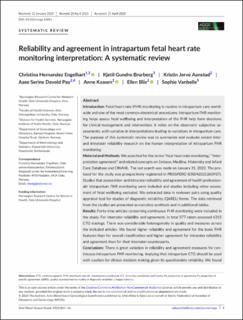Reliability and agreement in intrapartum fetal heart rate monitoring interpretation: A systematic review
Engelhart, Christina Hernandez; Brurberg, Kjetil Gundro; Aanstad, Kristin Jerve; Pay, Aase Serine Devold; Kaasen, Anne; Blix, Ellen; Vanbelle, Sophie
Peer reviewed, Journal article
Published version
Date
2023Metadata
Show full item recordCollections
Original version
10.1111/aogs.14591Abstract
Introduction
Fetal heart rate (FHR) monitoring is routine in intrapartum care worldwide and one of the most common obstetrical procedures. Intrapartum FHR monitoring helps assess fetal wellbeing and interpretation of the FHR help form decisions for clinical management and intervention. It relies on the observers' subjective assessments, with variation in interpretations leading to variations in intrapartum care. The purpose of this systematic review was to summarize and evaluate extant inter- and intrarater reliability research on the human interpretation of intrapartum FHR monitoring.
Material and Methods
We searched for the terms “fetal heart rate monitoring,” “interpretation agreement” and related concepts on Embase, Medline, Maternity and Infant Care Database and CINAHL. The last search was made on January 31, 2022. The protocol for the study was prospectively registered in PROSPERO (CRD42021260937). Studies that assess inter- and intrarater reliability and agreement of health professionals' intrapartum FHR monitoring were included and studies including other assessment of fetal wellbeing excluded. We extracted data in reviewer pairs using quality appraisal tool for studies of diagnostic reliability (QAREL) forms. The data retrieved from the studies are presented as narrative synthesis and in additional tables.
Results
Forty-nine articles concerning continuous FHR monitoring were included in the study. For interrater reliability and agreement, in total 577 raters assessed 6315 CTG tracings. There was considerable heterogeneity in quality and measures across the included articles. We found higher reliability and agreement for the basic FHR features than for overall classification and higher agreement for intrarater reliability and agreement than for their interrater counterparts.
Conclusions
There is great variation in reliability and agreement measures for continuous intrapartum FHR monitoring, implying that intrapartum CTG should be used with caution for clinical decision making given its questionable reliability. We found few high-quality studies and noted methodological concerns in the studies. We recommend a more standardized approach to future reliability studies on FHR monitoring.

